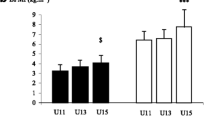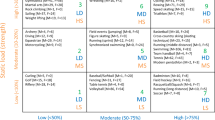Abstract
Objective
To investigate the association between body composition parameters and the metabolic profile of recreational female futsal players.
Methods
11 recreational female futsal players (21.2 ± 1.4 years, 163.2 ± 4.0 cm and 61.3 ± 17.6 kg) participated in this study. The assessment of body composition was performed using Dual Energy X-ray Absorptiometry, and the following body composition variables were evaluated: total body mass (TBM); body mass index (BMI); total body fat; relative total body fat; upper body fat (UBF); relative upper body fat (RUBF); lean mass (LM); lower limb muscle mass (LLMM). In addition, an evaluation of the metabolic profile was conducted: triacylgrycerol (TAG), total cholesterol (TC), low-density lipoprotein cholesterol (LDL-c), high-density lipoprotein cholesterol (HDL-c) and plasma concentrations of glucose (Glu). For the statistical analysis, descriptive analysis and the Pearson test were used to verify association between metabolic profile and body composition. The significance level was 5 %. Results: No significant association was found between TAG, HDL-c, and TC/HDL-c to body composition variables, while LDL-c had a tendency to associate with TBM (r = 0.54; p = 0.08) as well as Glu to BMI (r = −0.56; p = 0.07), and TBM (r = −0.59; p = 0.05). Significant association was found between Glu and LM (r = −0.73; p < 0.01) and TC with LLMM (r = 0.59; p = 0.055).
Conclusion
No significant association was found between the metabolic profile and body fat indices, which may be explained by the relatively low levels of TAG, TC, and LDL-c.


Similar content being viewed by others
References
Garcia Hermoso A, Saavedra Garcia JM, Escalante Gonzalez Y, Dominguez Pachon AM (2014) Effect of long-term physical exercise program and/or diet on metabolic syndrome in obese boys. Nutr Hosp 30(1):94–103
Mann S, Beedie C, Jimenez A (2014) Differential effects of aerobic exercise, resistance training and combined exercise modalities on cholesterol and the lipid profile: review, synthesis and recommendations. Sports Med 44(2):211–221
Schaffer A, Verdoia M, Cassetti E, Barbieri L, Perrone-Filardi P, Marino P et al (2015) Impact of red blood cells count and high density lipoproteins with the prevalence and extent of coronary artery disease. J Thromb Thrombolysis 40(1):61–68. doi:10.1007/s11239-015-1174-x
Brites FD, Fernandez KM, Zunino MJ, Yael MJ, Lardo M, Castro GR et al (1999) Partial lecithin-cholesterol acyltransferase (LCAT) deficiency syndrome. Medicina 59(1):89–92
Pedersen BK, Saltin B (2006) Evidence for prescribing exercise as therapy in chronic disease. Scand J Med Sci Sports 16(Suppl 1):3–63
Aadahl M, von Huth Smith L, Pisinger C, Toft UN, Glumer C, Borch-Johnsen K et al (2009) Five-year change in physical activity is associated with changes in cardiovascular disease risk factors: the Inter99 study. Prev Med 48(4):326–331
Law MR, Wald NJ, Thompson SG (1994) By how much and how quickly does reduction in serum cholesterol concentration lower risk of ischaemic heart disease? BMJ 308(6925):367–372
Earnest CP, Artero EG, Sui X, Lee DC, Church TS, Blair SN (2013) Maximal estimated cardiorespiratory fitness, cardiometabolic risk factors, and metabolic syndrome in the aerobics center longitudinal study. Mayo Clin Proc 88(3):259–270
Calabresi L, Franceschini G (2010) Lecithin:cholesterol acyltransferase, high-density lipoproteins, and atheroprotection in humans. Trends Cardiovasc Med 20(2):50–53
Lira FS, Carnevali LC Jr, Zanchi NE, Santos RV, Lavoie JM, Seelaender M (2012) Exercise intensity modulation of hepatic lipid metabolism. J Nutr Metab 2012:809576
Padulo J, Powell D, Milia R, Ardigo LP (2013) A paradigm of uphill running. PLoS ONE 8(7):e69006
Chamari K, Padulo J (2015) ‘Aerobic’ and ‘Anaerobic’ terms used in exercise physiology: a critical terminology reflection. Sports Med Open 1(1):1–4
Calcaterra V, Larizza D, Codrons E, De Silvestri A, Brambilla P, Abela S et al (2013) Improved metabolic and cardiorespiratory fitness during a recreational training program in obese children. J Pediatr Endocrinol Metab 26(3–4):271–276
de Sousa MV, Fukui R, Krustrup P, Pereira RM, Silva PR, Rodrigues AC et al (2014) Positive effects of football on fitness, lipid profile, and insulin resistance in Brazilian patients with type 2 diabetes. Scand J Med Sci Sports 24(Suppl 1):57–65
Imamura H, Nagata A, Oshikata R, Yoshimura Y, Miyamoto N, Miyahara K et al (2013) High-density lipoprotein cholesterol subfractions and lecithin: cholesterol acyltransferase activity in collegiate soccer players. Int J Sports Med 34(5):398–401
Brites F, Verona J, De Geitere C, Fruchart JC, Castro G, Wikinski R (2004) Enhanced cholesterol efflux promotion in well-trained soccer players. Metab Clin Exp 53(10):1262–1267
Zanella AM, Nakazone MA, Pinhel MA, Souza DR (2011) Lipid profile, apolipoprotein A-I and oxidative stress in professional footballers, sedentary individuals, and their relatives. Arquivos brasileiros de endocrinologia e metabologia 55(2):121–126
Arsic A, Vucic V, Tepsic J, Mazic S, Djelic M, Glibetic M (2012) Altered plasma and erythrocyte phospholipid fatty acid profile in elite female water polo and football players. Appl Physiol Nutr Metab 37(1):40–47
Dogramaci SN, Watsford ML, Murphy AJ (2011) Time-motion analysis of international and national level futsal. J Strength Conditioning Res Natl Strength Conditioning Assoc 25(3):646–651
Ammar A, Chtourou H, Trabelsi K, Padulo J, Turki M, El Abed K et al (2015) Temporal specificity of training: intra-day effects on biochemical responses and Olympic-Weightlifting performances. J Sports Sci 33(4):358–368
Angoorani H, Haratian Z, Mazaherinezhad A, Younespour S (2014) Injuries in iran futsal national teams: a comparative study of incidence and characteristics. Asian J Sports Med 5(3):e23070
Milanez VF, Ramos SP, Okuno NM, Boullosa DA, Nakamura FY (2014) Evidence of a non-linear dose-response relationship between training load and stress markers in elite female futsal players. J Sports Sci Med 13(1):22–29
Ruiz JR, Labayen I, Ortega FB, Moreno LA, Rodriguez G, Breidenassel C et al (2014) Physical activity, sedentary time, and liver enzymes in adolescents: the HELENA study. Pediatr Res 75(6):798–802
LeMura LM, von Duvillard SP, Andreacci J, Klebez JM, Chelland SA, Russo J (2000) Lipid and lipoprotein profiles, cardiovascular fitness, body composition, and diet during and after resistance, aerobic and combination training in young women. Eur J Appl Physiol 82(5–6):451–458
Bangsbo J, Nielsen JJ, Mohr M, Randers MB, Krustrup BR, Brito J et al (2010) Performance enhancements and muscular adaptations of a 16-week recreational football intervention for untrained women. Scand J Med Sci Sports 20(Suppl 1):24–30
Durstine JL, Grandjean PW, Cox CA, Thompson PD (2002) Lipids, lipoproteins, and exercise. J Cardpulm Rehabil 22(6):385–398
Randers MB, Andersen LJ, Orntoft C, Bendiksen M, Johansen L, Horton J et al (2013) Cardiovascular health profile of elite female football players compared to untrained controls before and after short-term football training. J Sports Sci 31(13):1421–1431
Stasiulis A, Mockiene A, Vizbaraite D, Mockus P (2010) Aerobic exercise-induced changes in body composition and blood lipids in young women. Medicina 46(2):129–134
Kostrzewa-Nowak D, Nowak R, Jastrzebski Z, Zarebska A, Bichowska M, Drobnik-Kozakiewicz I et al (2015) Effect of 12-week-long aerobic training programme on body composition, aerobic capacity, complete blood count and blood lipid profile among young women. Biochem Med 25(1):103–113
Katzmarzyk PT, Leon AS, Rankinen T, Gagnon J, Skinner JS, Wilmore JH et al (2001) Changes in blood lipids consequent to aerobic exercise training related to changes in body fatness and aerobic fitness. Metab Clin Exp 50(7):841–848
Author information
Authors and Affiliations
Corresponding author
Ethics declarations
Conflict of interest
The authors declare that they have no conflict of interest.
Ethical approval
All procedures performed in studies involving human participants were in accordance with the ethical standards of the institutional and/or national research committee and with the 1964 Helsinki declaration and its later amendments or comparable ethical standards.
Informed consent
Informed consent was obtained from all individual participants included in the study.
Rights and permissions
About this article
Cite this article
Campos, E.Z., Gerosa-Neto, J., Lira, F.S. et al. Metabolic profile is not associated with body composition parameters in recreational female futsal players. Sport Sci Health 12, 63–67 (2016). https://doi.org/10.1007/s11332-015-0254-9
Received:
Accepted:
Published:
Issue Date:
DOI: https://doi.org/10.1007/s11332-015-0254-9




